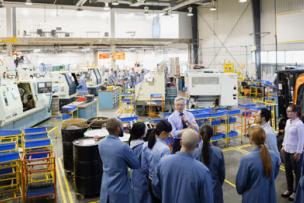Ask the Experts: Tax Reform Should Help Grow Future Profits and Hire New Talent
The impact of tax reform is expected to spur training and hiring in manufacturing. Will it make a dent in the skills gap? Some experts believe it can.
What You Need to Know
As a small to midsize manufacturer, have you been holding off on making capital purchases? Tax experts and manufacturing industry insiders discuss the impact of changes in the tax laws via reform—and the immediate value of being able to expense 100 percent of capital costs.
The recently passed tax reform law lets manufacturers retain more funds for their business, which should enable them to plan more strategically to meet two of their most critical needs: capital equipment and skilled employees.
The law’s new provisions on expensing and depreciation provide an attractive five-year window in which to acquire new equipment and upgrade facilities. The limit on Section 179 expensing was raised from $500,000 to $1 million, and the definition of the kinds of expenses that qualify was expanded. Now businesses can fully expense improvements to roofs; heating, ventilation and air conditioning systems; fire protection and alarm systems; and security systems. The new law also increased bonus depreciation for capital expenditures, so companies can now deduct 100 percent of the cost of new or used equipment in the year it is purchased and put into service, compared to the previous 50 percent.
Small and Midsize Companies to Reap the 100 Percent Write-Off Benefits, Say Industry Insiders
If a manufacturer buys a $300,000 piece of equipment, for example, “you now can reduce your taxable income by that amount in the current year, versus previously having to expense that $300,000 over a period of, say, five years,” says Brian Kitchen, tax director at Kreischer Miller, which counts many midsize and small manufacturers among its clients. “That will allow a lot of manufacturers to reinvest in new equipment.”
That’s critically important for small and midsize companies, which despite their size must still purchase large, expensive pieces of equipment, says Omar S. Nashashibi, founding partner of The Franklin Partnership LLP and head of government relations for One Voice, the advocacy program of the Precision Metalforming Association and the National Tooling and Machining Association. “A company that might make only $5 million in sales still has to spend $500,000 to $1 million on a stamping press just to get up and running,” he notes. A recent survey of association members found they spent an average of $870,000 on heavy equipment and machines last year, the highest since 2014.
The increase in 179 expensing is permanent, so it boosts a business’s purchasing power for the foreseeable future. The 100 percent bonus depreciation will begin phasing out in 2023, so companies need to develop a strategy. Nashashibi is advising that companies project their equipment and facility needs over the next five years. It can take 18 months for a manufacturer to purchase, install and get a piece of machinery up and running, he notes. “Look at your opportunities for expansion, then target a date by which you want to achieve that and work backward from there,” he explains.
Before tax reform, such planning was nearly impossible. “We kept dealing with provisions that were expiring every year. We’d literally have bankers sending out notices in October to customers saying, ‘Bonus depreciation expires on Dec. 31. Act now.’”
What is the impact of tax reform on large manufacturers? Read “Better MRO Asks Experts to Weigh In on Tax Reform Opportunities for Manufacturers” to find out.
Experts Expect Manufacturers to Hire and Train More Employees, Too
Manufacturers will likely use a healthy portion of their tax savings to invest in employees, both current and new. Upskilling and training are top priorities for the small and midsize manufacturers Nashashibi represents. Manufacturers want to offer more training to current workers to help them qualify for promotion. “In many cases, these employees went to high school with the owners,” he says. “They’ve known each other for decades, so they really are part of the family.”
Although it was in danger of being repealed at one point during debate of the tax reform bill, Section 127—educational assistance programs—was retained. Under this provision, employers can deduct up to $5,250 in tuition they provide to an employee.
Next, manufacturers will look to hire new employees, if they can be found. According to the survey, employers want to hire an average of 5.8 new employees in 2018. However, “We’re seeing manufacturers interviewing 30 to 40 people and maybe only a handful of them are even qualified for the job,” Nashashibi says.
The new law created a new tax credit for family and medical leave, says Jim Brandenburg, tax partner at Sikich. For tax years 2018 and 2019, employers can receive a credit of 25 percent if they pay at least 100 percent of an employee’s regular wage during such leave. The provision applies to employees making $72,000 or less who have been with the company for at least a year. Employers are required to have a written paid leave plan in place and to keep documentation on costs.
"A company that might make only $5 million in sales still has to spend $500,000 to $1 million on a stamping press just to get up and running."
Some Tax Savings to Benefit Apprenticeships and Target the Skills Gap
Employers could also use their tax savings to increase what they are already doing to seed their local market with qualified young people. This includes funding more scholarships at local universities and investing in more manufacturing apprentice programs at local high schools and community colleges. Nashashibi adds that there are moves in Congress to update current education laws to encourage more vocational education, as awareness increases of the great career opportunities in manufacturing. “There is a 26-year-old in South Bend, Indiana, making $110,000 in a manufacturing job right now,” he says.
How are small to midsize manufacturers handling the skills gap? Read how one company puts real effort in the local community and in clear career path documentation and training.
There is an interesting interplay between manufacturers’ need for equipment and their need for qualified employees. “Most of our members are busier than they’ve been in years,” says Nashashibi. “The workforce shortage is going to lead to more machines being bought. The fewer employees that are available to hire, the more manufacturers will need increased automation, robots and machines that can be run by a single individual rather than multiple people on the shop floor.” That, in turn, makes the new equipment expensing and depreciation provisions all the more important in a company’s five-year plan.





Talk to Us!
Leave a reply
Your email address will not be published. Required fields are marked *